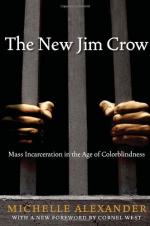
|
| Name: _________________________ | Period: ___________________ |
This test consists of 5 multiple choice questions, 5 short answer questions, and 10 short essay questions.
Multiple Choice Questions
1. When was Christopher Lee Armstrong's motel room raided, leading to his arrest for conspiracy to distribute crack cocaine?
(a) June, 2000.
(b) September, 1991.
(c) May, 1989.
(d) April, 1992.
2. Who is attributed to the following quotation in Chapter 3: "The Color of Justice": "there is no immaculate perception"?
(a) Friedrich Nietzsche.
(b) Douglas Blackmon.
(c) C. Vann Woodward.
(d) W. E. B. Du Bois.
3. The quote from Frederick Douglass that opens Chapter 4: "The Cruel Hand" was a part of a statement on behalf of delegates to the National Colored Convention held when?
(a) 1853.
(b) 1869.
(c) 1872.
(d) 1845.
4. How much was the fine that Ora Lee Hurley owed and was imprisoned for being unable to pay?
(a) $816.
(b) $705.
(c) $500.
(d) $345.
5. The author uses a metaphor in Chapter 5: "The New Jim Crow" to describe the circumstances of white Americans who are harmed by the War on Drugs. To whom are these white Americans compared?
(a) Afghani civilians harmed by U.S. military operations.
(b) Korean civilians harmed by U.S. military operations.
(c) Iraqi civilians harmed by U.S. military operations.
(d) Vietnamese civilians harmed by U.S. military operations.
Short Answer Questions
1. The increase in the number of African American males sent to prison for drug crimes increased by what percentage between 1985 and 2005?
2. When was the Anti-Drug Abuse Act passed that called for strict lease enforcement and eviction of public housing tenants who engage in criminal activity?
3. For what crime(s) did Warren McCleskey face the death penalty?
4. Who is attributed to the quote in Chapter 5: "The New Jim Crow," "Nothing in all the world is more dangerous than sincere ignorance and conscientious stupidity"?
5. Who is the former executive director of the National Center for Institutions and Alternatives that is cited as saying, "There are certain code words that allow you never to have to say 'race' but everybody knows that's what you mean"?
Short Essay Questions
1. How does the author compare the circumstances of a freed prisoner to those of a black person living in Mississippi at the height of Jim Crow in Chapter 4: "The Cruel Hand"?
2. What circumstances led to Clinton Drake's inability to vote?
3. What is the "Black Box" that the author refers to in Chapter 4: "The Cruel Hand"?
4. How is Iris Marion Young's "birdcage" metaphor described in Chapter 5: "The New Jim Crow"?
5. What was determined in the Supreme Court case of Rucker v. Davis?
6. What is the Baldus study? What were the conclusions of the study?
7. When was crack-cocaine introduced to users in the U.S.? What involvement did the government have with the introduction of crack to African American communities?
8. What were the repercussions of Emma Faye Stewart's decision to take a plea deal?
9. How does political disenfranchisement apply to Jim Crow and mass incarceration, according to the author in Chapter 5: "The New Jim Crow"?
10. How does the author describe the crime statistics of Chicago in regard to race in Chapter 5: "The New Jim Crow"?
|
This section contains 922 words (approx. 4 pages at 300 words per page) |

|




